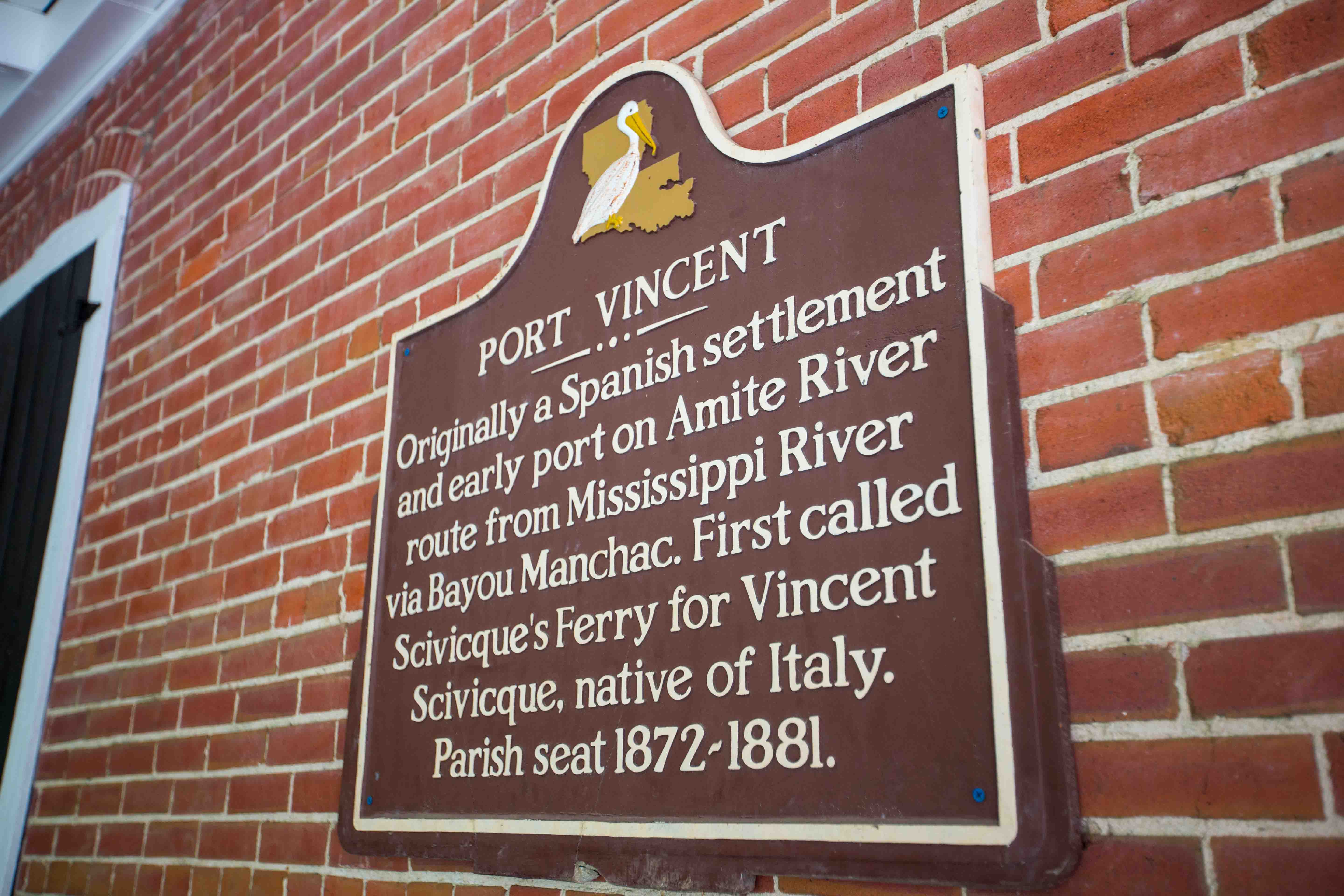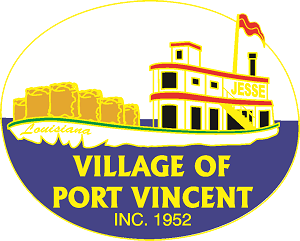From the book entitled “The Free State – A History and Place-Names Study of Livingston Parish” by the members of the Livingston Parish American Revolution Bicentennial Committee in cooperation with the Livingston Parish Police Jury and the Louisiana American Revolution Bicentennial Commission, 1976. Reprinted by permission. Dedicated to the memory of Reuben Cooper and Raymond Riggs.
Port Vincent (Subique’s Ferry) is located at the head of the navigable part of the Amite River in T8S-R4E of the Greensburg Land District. La. Highways 16 and 42 link it with nearby communities. The land area is an average of 15 feet above sea level and consists of ridges, bottoms, and swamps. Pines dominate the ridges and hardwoods in the bottom, with bald cypress and tupelo in the swamps. The soil is fertile and well drained on the ridges with a claypan six to eight inches deep. Cotton was an important at one time, but later gave way to strawberries and other truck crops.


The village was incorporated on May 5, 1952 by the proclamation of Gov. Earl K. Long. G.J. Guitreau was appointed mayor; W.S. Abbott, Leo Cambre, and C.V. Richard, aldermen; and O.A. Bercegeay, marshal. (1) Port Vincent’s post office was established on Feb. 18, 1833 with John J. Buck as postmaster. This office was replaced by one called Beech Hill on May 28, 1835. The Coelk Post Office was established on Dec. 28, 1848 and continued under this name until January 27, 1874 when the name again became Port Vincent. It was discontinued with the retirement of Postmaster Henry Berthelot on Feb. 28, 1954, exactly 121 years after its establishment. The village is now served by a rural route from Denham Springs. (2)
Port Vincent was the parish seat from 1872 until 1881. The courthouse there burned on Oct. 15, 1875, destroying the public records. (3)
Two newspapers, the Port Vincent Tribune and The Livingstonian, were published in the latter part of the 1800’s. The former was sold to the Donaldsonville Chief in July, 1877, but its editor, Harry Gould, came out with The Livingstonian in May 1878 in Port Vincent.
The July 22, 1873 issue of the Tribune contained a map of the town laid out in squares and lots. Street names from the Amite River north include Water, Church, Ascension, St. Anne, Davidson, Clio, Livingston Avenue, Main, St. Vincent, Cooper and Waterson. (4)
Port Vincent was an early inland port and Spanish settlement populated prior to 1800 by Spanish settlers from nearby Galveztown in Ascension Parish. Original land grants show large property owners as William Willis, Jose Alamo, Pedro Cosset, William Watson and Joseph Deis. (5)


It is recorded that Iberville, the French explorer and colonist, used Bayou Manchac and the Amite River as a route between the Mississippi and the Gulf of Mexico in 1699. Port Vincent later became an important shipping point on this route, as it was used by Spaniards from the late 1700’s until 1812 when General Andrew Jackson caused the Mississippi River entrance to Bayou Manchac to be closed by a dam and other obstructions. Vincent Scivicque (1784 – 1870), a native of Italy, is considered to be the founder of Port Vincent. Scivicque was a merchant and owner of a schooner that sailed the Amite River bringing slaves to this area. An early article on Port Vincent and Livingston Parish denotes Scivicque as a companion and follower of the famous Lafitte. (6) The Port Vincent area was also referred to as “Subique’s Ferry” in many contemporary articles, as this was a main crossing point on the Amite River. In fact, this is the name by which the community is referred to on an 1864 map of Livingston Parish.
Scivicque donated a 60 by 60 square foot plot of land for the community cemetery in 1824. (7) It was intended for use by the descendants of the families of Scivicque, Alexandre Brignac, and Augusta Gregoire.
Scivicque built a small chapel on land he donated, and it was blessed by a Mass on Aug. 20, 1839. (8)
William Watson, an original settler, contributed greatly to the growth of Port Vincent and Livingston Parish. The Watson family still holds
their reunions in the community, and the Watson Cemetery, although no longer used, is still noted on the 1963 French Settlement Quadrangle Map.
In 1855 Captain Thomas C. Gibbens, an engineer, began the operation
of the earliest known sawmill in Port Vincent. (9) In 1860 he married Agnes Scivicque, daughter of Vincent Scivicque.
Port Vincent was a thriving community in the days when the Amite River was the primary means of transportation. The Port Vincent Brick and Stave Mill, sawmills, a cotton gin, a warehouse, boat docks, schools, churches, boarding houses, and many business establishments dwindled when the railways bypassed Port Vincent.
The village is now a resort for many fishermen, boaters, skiers, and persons retreating for a weekend from the crowded cities. The population in 1970 was 387, but it continues to grow. — Mercy Cambre, Pam Lass and Mrs. Jonnie Doris.


(1) Louisiana Secretary of State’s Office, “Records of Municipal Officers,” Baton Rouge.
(2) “US Post Office Department Records” (Record Group 28), National Archives.
(3) Forrest, Clark, Jr. Variou Locations of the Livingston Parish Courthouse, Southeast Louisiana Historical Association Papers, Hammond: By the Association, 1975.
(4) Copies at the Louisiana State University Library, Baton Rouge, and the Denham Springs News, Denham Springs.
(5) State Land Office, Baton Rouge.
(6) Men and matters, Vol. 8, January-February, 1902, No. 2-3, pp. 8-12.
(7) Conveyance Records, St. Helena Parish Courthouse, Greensburg.
(8) Church records, St. Joseph Catholic Church, French Settlement.
(9) Southwest Louisiana Biographical and Historical, by William Henry Perrin, pp. 43-44.
Port Vincent (Subique’s Ferry), Livingston Parish, Louisiana File prepared by D.N. Pardue
Submitted to the LAGenWeb Archives
**********************************************
Copyright. All rights reserved.
http://usgwarchives.net/copyright.htm
http://usgwarchives.net/la/lafiles.htm
**********************************************
